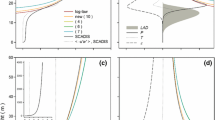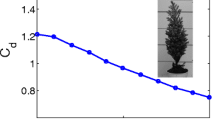Abstract
A simple tree swaying model, valid for windstorm conditions, has been developed for the purpose of simulating the effect of strong wind on the vulnerability of heterogeneous forest canopies. In this model the tree is represented as a flexible cantilever beam whose motion, induced by turbulent winds, is solved through a modal analysis. The geometric nonlinearities related to the tree curvature are accounted for through the formulation of the wind drag force. Furthermore, a breakage condition is considered at very large deflections. A variety of case studies is used to evaluate the present model. As compared to field data collected on three different tree species, and to the outputs of mechanistic models of wind damage, it appears to be able to predict accurately large tree deflections as well as tree breakage, using wind velocity at tree top as a forcing function. The instantaneous response of the modelled tree to a turbulent wind load shows very good agreement with a more complex tree model. The simplicity of the present model and its low computational time make it well adapted to future use in large-eddy simulation airflow models, aimed at simulating the complete interaction between turbulent wind fields and tree motion in fragmented forests.












Similar content being viewed by others
References
de Langre E (2008) Effects of wind on plants. Annu Rev Fluid Mech 40:141–168
Doaré O, Moulia B, de Langre E (2004) Effect of plant interaction on wind-induced crop motion. J Biomech Eng 126(2):146–51
Dupont S, Brunet Y (2006) Simulation of turbulent flow in an urban forested park damaged by a windstorm. Boundary-Layer Meteorol 120(1):133–161
Dupont S, Brunet Y (2008) Edge flow and canopy structure: a large-eddy simulation study. Boundary-Layer Meteorol 126:51–71
Dupont S, Brunet Y, Finnigan JJ (2008) Large-eddy simulation of turbulent flow over a forested hill: validation and coherent structure identification. Q J R Meteorol Soc 134:1911–1929
Dupont S, Gosselin F, Py C, de Langre E, HTmon P, Brunet Y (2010) Modelling waving crops using large-eddy simulation: comparison with experiments and a linear stability analysis. J Fluid Mech 652:5–44
Dupuy L, Fourcaud T, Stokes A (2005) A numerical investigation into the influence of soil type and root architecture on tree anchorage. Plant Soil 278:119–134
Dupuy L, Fourcaud T, Lac P, Stokes A (2007) A generic 3D finite element model of tree anchorage integrating soil mechanics and real root system architecture. Am J Bot 94:1506–1514
Finnigan JJ, Mulhearn PJ (1978) A simple mathematical model of airflow in waving plant canopies. Boundary-Layer Meteorol 14:415–431
Flesch TK, Wilson JD (1999) Wind and remnant tree sway in forest cutblocks II. Relating measured tree sway to wind statistics. Agric For Meteorol 93(4):243–258
Gardiner B, Stacey G, Belcher R, Wood C (1997) Field and wind tunnel assessments of the implications of respacing on tree stability. Forestry 70:233–252
Gardiner B, Peltola H, KellomSki S (2000) Comparison of two models for predicting the critical wind speeds required to damage coniferous trees. Ecol Model 129:1–23
Gardiner B, Blennow K, Carnus JM, Fleischer P, Ingemarson F, Landmann G, Lindner M, Marzano M, Nicoll B, Orazio C, Peyron JL, Reviron MP, Schelhaas MJ, Schuck A, Spielmann M, Usbeck T (2010) Destructive storms in European forests: past and forthcoming impacts. In: Technical report. EC DG environment. http://ec.europa.eu/environment/forests/fprotection.htm
Gardiner B, Blennow K, Carnus J, Fleischer P, Ingemarson F, Landmann G, Lindner M, Marzano M, Nicoll B, Orazio C, Peyron J, Reviron M, Schelhaas M, Schuck A, Spielmann M, Usbeck T (2012) Destructive storms in European forest: past and forthcoming impacts. In: Technical report. European Forest Institute
Gatti-Bono C, Perkins N (2004) Numerical model for the dynamics of a coupled fly line/fly rod system and experimental validation. J Sound Vib 272:773–791
Geradin M, Rixen D (1997) Mechanical vibrations. Elsevier, Masson
Gosselin F, de Langre E (2009) Destabilising effects of plant flexibility in air and aquatic vegetation canopy flows. Eur J Mech B Fluids 28:271–282
Gosselin F, de Langre E (2011) Drag reduction by reconfiguration of a poroelastic system. J Fluids Struct 27:1111–1123
Gosselin F, de Langre E, Machado-Almeida BA (2010) Drag reduction of flexible plates by reconfiguration. J Fluid Mech 650:319–341
Kerzenmacher T, Gardiner B (1998) A mathematical model to describe the dynamic response of a spruce tree to the wind. Trees 12:385–394
Neild SA, Wood CJ (1999) Estimating stem and root-anchorage flexibility in trees. Tree Physiol 19,3:141–151
Py C, de Langre E, Moulia B (2006) A frequency lock-in mechanism in the interaction between wind and crop canopies. J Fluid Mech 568:425–449
Rodriguez M, de Langre E, Moulia B (2008) A scaling law for the effects of architexture and allometry on tree vibration modes suggests a biological tuning to modal compartmentalization. Am J Bot 95:1523–1537
Sellier D, Brunet Y, Fourcaud T (2008) A numerical model of tree aerodynamic response to a turbulent airflow. Forestry 81:279–297
Sobottka G, Lay T, Weber A (2008) Stable integration of the dynamic cosserat equations with application to hair modeling. J WSCG 16:73–80
Theckes B, de Langre E, Boutillon X (2011) Damping by branching: a bioinspiration from trees. Bioinsp Biomimetics 6:046010
Voltera E, Zachmanoglou EC (1965) Dynamics of vibrations. Charles E. Merrill Books Inc, Columbus
Webb VA, Rudnicki M (2009) A linear analysis of the interaction between the atmosphere and an underlying compliant plant canopy. Boundary-Layer Meteorol 133:93–111
Acknowledgments
We express sincere thanks to Drs B. Gardiner, E. de Langre, F. Gosselin and D. Sellier for helpful discussions. The ANR is gratefully acknowledged for its financial support to the ‘CHENE-ROSEAU’ programme. Finally, we thank the three anonymous reviewers for their helpful comments.
Author information
Authors and Affiliations
Corresponding author
Additional information
Communicated by E. Priesack.
Appendix
Appendix
A mode shape and frequency
The mode shapes \(\varphi_{j}\) and frequencies f j of a cylindric cantilever beam of height h, with a clamped origin and a free end, can be deduced from the linearised Euler–Bernoulli equation, assuming that d i (s, t) < < h (Voltera and Zachmanoglou 1965).
The mode shapes are deduced from:
where the variable α j is deduced from \(\cosh(\alpha_{j}h)\cos(\alpha_{j}h)+1=0\) by using a Newton–Raphson method.
These modes form an orthogonal modal basis where the scalar product of two modes is defined as:
The frequency of each mode j can be obtained from:
where E, ρ w, I (=π D 4/64), and S w (=π D 2/4) are the Young modulus, the wood density, the second moment of inertia and the cross-sectional area of the beam, respectively. As in this approach all ingredients of f j in Eq. (8) are considered constant, whereas in reality they vary along the tree, the frequencies of the various modes calculated this way may differ from the measured frequencies. This parametrisation turns out to be well adapted for the first frequency as it is closely related to the trunk vibration. For example, using Eq. (8) for the Maritime pine and taking a diameter value at mid-canopy height, a frequency value of 0.16 Hz is obtained, close to the measured value of 0.18 Hz (Sellier et al. 2008).
Rights and permissions
About this article
Cite this article
Pivato, D., Dupont, S. & Brunet, Y. A simple tree swaying model for forest motion in windstorm conditions. Trees 28, 281–293 (2014). https://doi.org/10.1007/s00468-013-0948-z
Received:
Revised:
Accepted:
Published:
Issue Date:
DOI: https://doi.org/10.1007/s00468-013-0948-z




